Lebanese vs Afghan Community Comparison
COMPARE
Lebanese
Afghan
Social Comparison
Social Comparison
Lebanese
Afghans
7,328
SOCIAL INDEX
70.8/ 100
SOCIAL RATING
122nd/ 347
SOCIAL RANK
7,658
SOCIAL INDEX
74.1/ 100
SOCIAL RATING
108th/ 347
SOCIAL RANK
Afghan Integration in Lebanese Communities
The statistical analysis conducted on geographies consisting of 138,539,246 people shows a mild negative correlation between the proportion of Afghans within Lebanese communities in the United States with a correlation coefficient (R) of -0.354. On average, for every 1% (one percent) increase in Lebanese within a typical geography, there is a decrease of 0.014% in Afghans. To illustrate, in a geography comprising of 100,000 individuals, a rise of 1,000 Lebanese corresponds to a decrease of 14.1 Afghans.
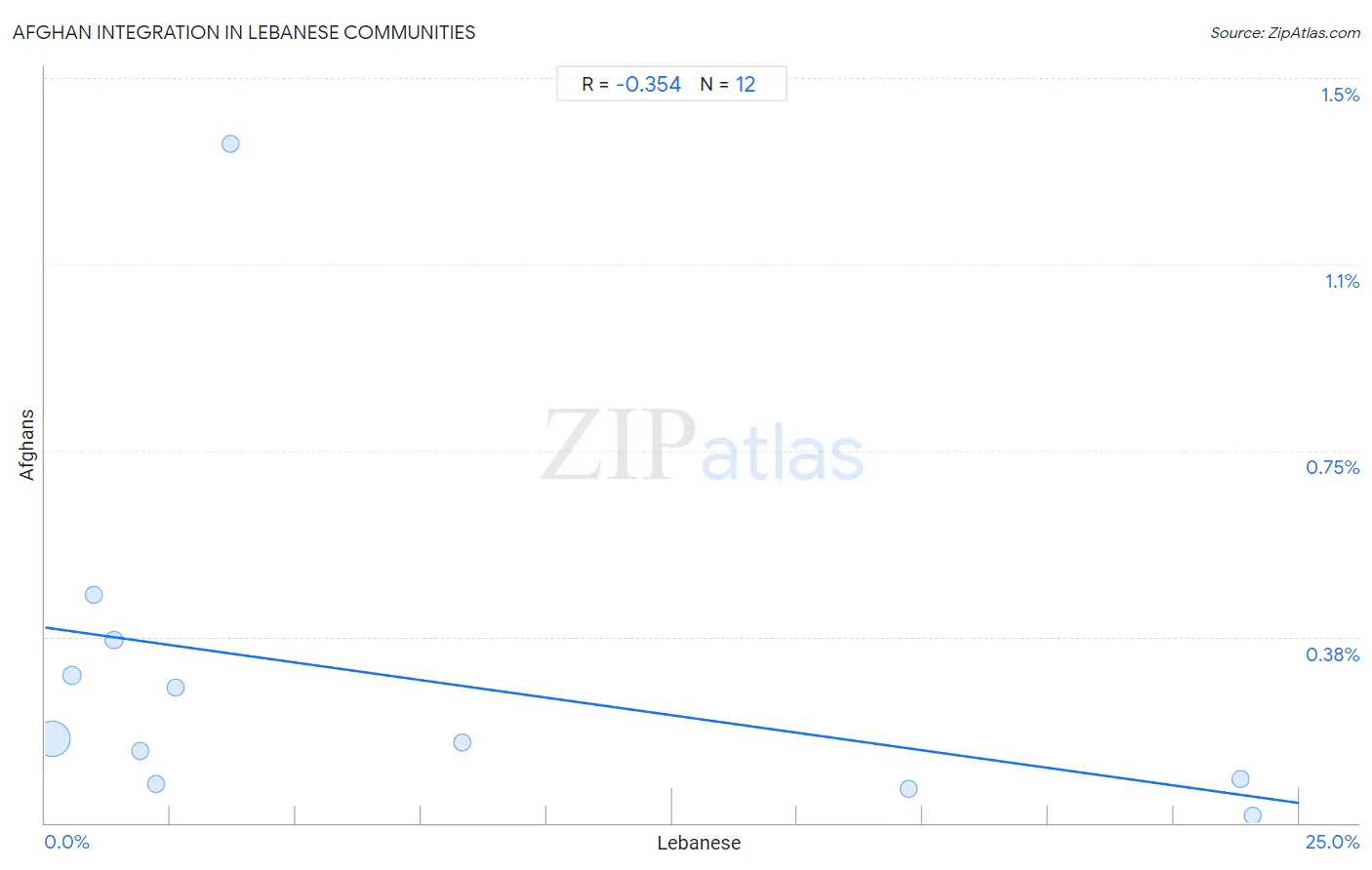
Lebanese vs Afghan Income
When considering income, the most significant differences between Lebanese and Afghan communities in the United States are seen in householder income under 25 years ($50,355 compared to $58,019, a difference of 15.2%), wage/income gap (27.9% compared to 24.9%, a difference of 11.8%), and householder income over 65 years ($62,287 compared to $68,951, a difference of 10.7%). Conversely, both communities are more comparable in terms of per capita income ($45,840 compared to $46,268, a difference of 0.93%), median male earnings ($57,409 compared to $59,554, a difference of 3.7%), and median family income ($107,086 compared to $112,971, a difference of 5.5%).

| Income Metric | Lebanese | Afghan |
| Per Capita Income | Exceptional $45,840 | Exceptional $46,268 |
| Median Family Income | Exceptional $107,086 | Exceptional $112,971 |
| Median Household Income | Excellent $88,091 | Exceptional $97,026 |
| Median Earnings | Exceptional $48,226 | Exceptional $51,112 |
| Median Male Earnings | Exceptional $57,409 | Exceptional $59,554 |
| Median Female Earnings | Good $40,006 | Exceptional $43,077 |
| Householder Age | Under 25 years | Tragic $50,355 | Exceptional $58,019 |
| Householder Age | 25 - 44 years | Excellent $97,339 | Exceptional $104,410 |
| Householder Age | 45 - 64 years | Exceptional $104,734 | Exceptional $112,676 |
| Householder Age | Over 65 years | Good $62,287 | Exceptional $68,951 |
| Wage/Income Gap | Tragic 27.9% | Excellent 24.9% |
Lebanese vs Afghan Poverty
When considering poverty, the most significant differences between Lebanese and Afghan communities in the United States are seen in single father poverty (17.7% compared to 14.0%, a difference of 26.9%), single male poverty (13.2% compared to 10.7%, a difference of 23.7%), and female poverty among 18-24 year olds (20.2% compared to 19.0%, a difference of 6.5%). Conversely, both communities are more comparable in terms of child poverty under the age of 16 (16.3% compared to 16.2%, a difference of 0.77%), family poverty (8.9% compared to 8.8%, a difference of 0.82%), and female poverty among 25-34 year olds (13.2% compared to 13.0%, a difference of 1.3%).
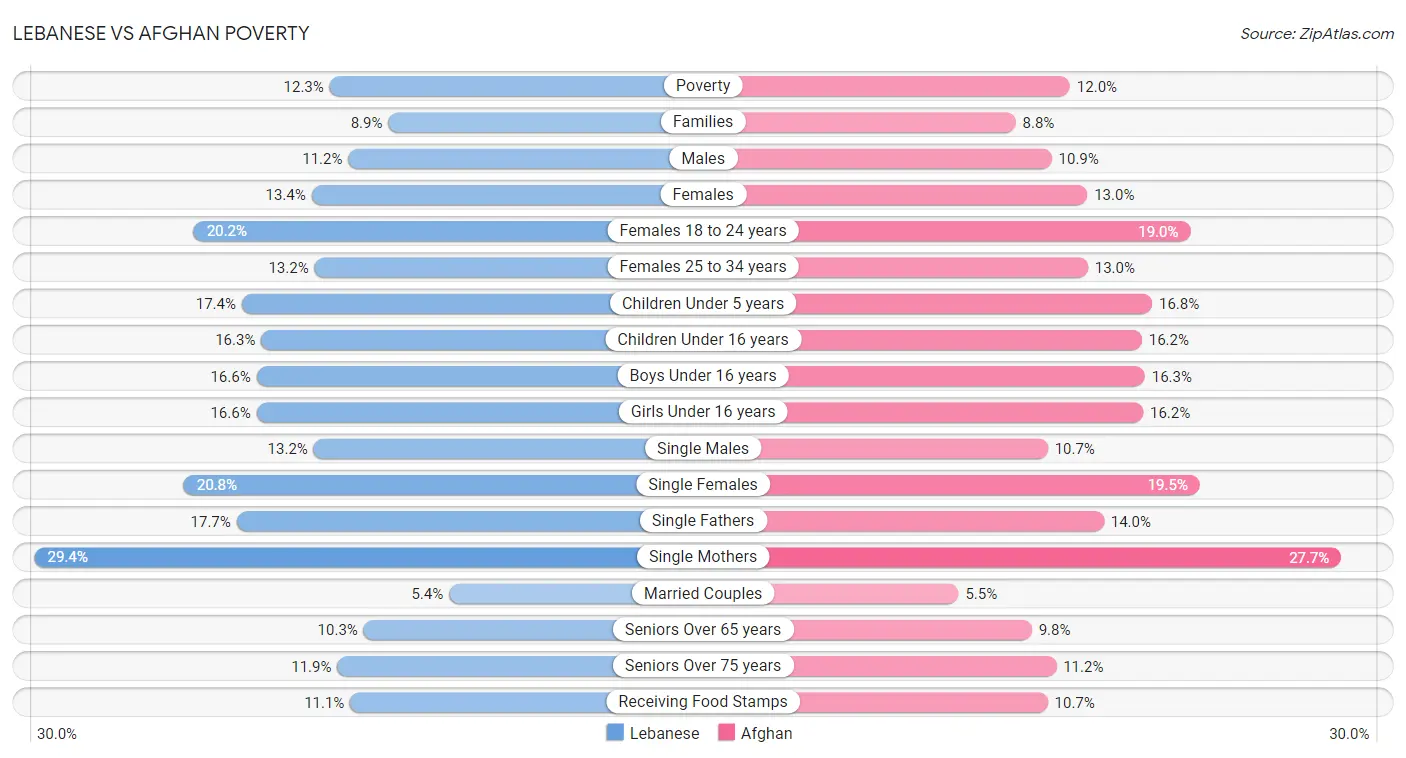
| Poverty Metric | Lebanese | Afghan |
| Poverty | Average 12.3% | Good 12.0% |
| Families | Average 8.9% | Good 8.8% |
| Males | Average 11.2% | Good 10.9% |
| Females | Average 13.4% | Good 13.0% |
| Females 18 to 24 years | Average 20.2% | Exceptional 19.0% |
| Females 25 to 34 years | Good 13.2% | Excellent 13.0% |
| Children Under 5 years | Average 17.4% | Good 16.8% |
| Children Under 16 years | Average 16.3% | Average 16.2% |
| Boys Under 16 years | Average 16.6% | Average 16.3% |
| Girls Under 16 years | Average 16.6% | Good 16.2% |
| Single Males | Tragic 13.2% | Exceptional 10.7% |
| Single Females | Good 20.8% | Exceptional 19.5% |
| Single Fathers | Tragic 17.7% | Exceptional 14.0% |
| Single Mothers | Fair 29.4% | Exceptional 27.7% |
| Married Couples | Fair 5.4% | Poor 5.5% |
| Seniors Over 65 years | Exceptional 10.3% | Exceptional 9.8% |
| Seniors Over 75 years | Good 11.9% | Exceptional 11.2% |
| Receiving Food Stamps | Excellent 11.1% | Exceptional 10.7% |
Lebanese vs Afghan Unemployment
When considering unemployment, the most significant differences between Lebanese and Afghan communities in the United States are seen in unemployment among women with children ages 6 to 17 years (9.5% compared to 7.6%, a difference of 25.3%), unemployment among women with children under 6 years (7.8% compared to 7.0%, a difference of 11.6%), and unemployment among ages 20 to 24 years (10.3% compared to 9.6%, a difference of 7.1%). Conversely, both communities are more comparable in terms of unemployment among ages 35 to 44 years (4.7% compared to 4.7%, a difference of 0.10%), unemployment among women with children under 18 years (5.4% compared to 5.4%, a difference of 0.15%), and unemployment among ages 45 to 54 years (4.4% compared to 4.4%, a difference of 0.23%).
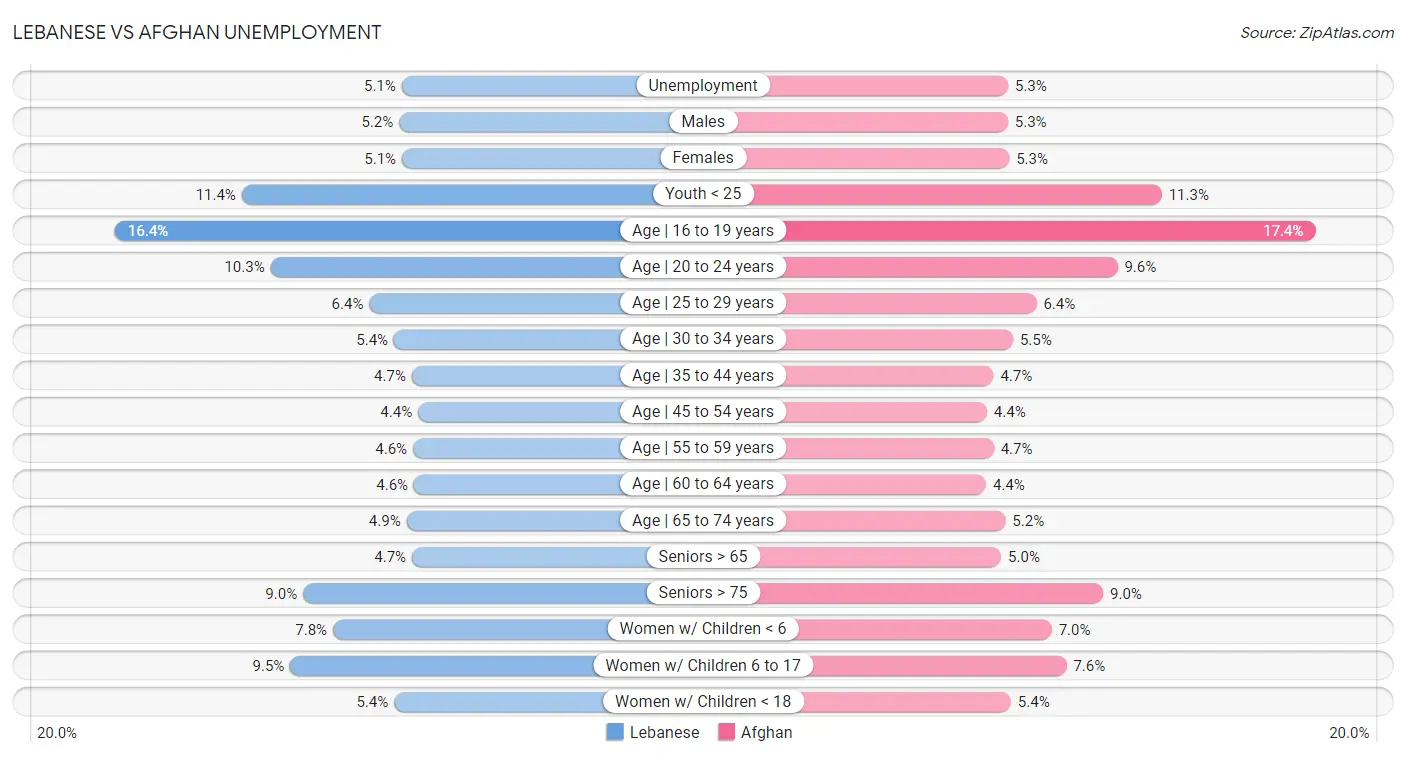
| Unemployment Metric | Lebanese | Afghan |
| Unemployment | Excellent 5.1% | Average 5.3% |
| Males | Good 5.2% | Good 5.3% |
| Females | Exceptional 5.1% | Fair 5.3% |
| Youth < 25 | Excellent 11.4% | Excellent 11.3% |
| Age | 16 to 19 years | Exceptional 16.4% | Good 17.4% |
| Age | 20 to 24 years | Average 10.3% | Exceptional 9.6% |
| Age | 25 to 29 years | Exceptional 6.4% | Exceptional 6.4% |
| Age | 30 to 34 years | Good 5.4% | Average 5.5% |
| Age | 35 to 44 years | Average 4.7% | Average 4.7% |
| Age | 45 to 54 years | Excellent 4.4% | Excellent 4.4% |
| Age | 55 to 59 years | Exceptional 4.6% | Exceptional 4.7% |
| Age | 60 to 64 years | Exceptional 4.6% | Exceptional 4.4% |
| Age | 65 to 74 years | Exceptional 4.9% | Exceptional 5.2% |
| Seniors > 65 | Exceptional 4.7% | Exceptional 5.0% |
| Seniors > 75 | Poor 9.0% | Tragic 9.0% |
| Women w/ Children < 6 | Fair 7.8% | Exceptional 7.0% |
| Women w/ Children 6 to 17 | Tragic 9.5% | Exceptional 7.6% |
| Women w/ Children < 18 | Good 5.4% | Good 5.4% |
Lebanese vs Afghan Labor Participation
When considering labor participation, the most significant differences between Lebanese and Afghan communities in the United States are seen in in labor force | age 16-19 (38.6% compared to 36.1%, a difference of 6.9%), in labor force | age > 16 (64.5% compared to 67.1%, a difference of 4.0%), and in labor force | age 20-64 (79.1% compared to 80.3%, a difference of 1.5%). Conversely, both communities are more comparable in terms of in labor force | age 25-29 (84.3% compared to 84.4%, a difference of 0.080%), in labor force | age 20-24 (75.3% compared to 75.2%, a difference of 0.17%), and in labor force | age 30-34 (84.4% compared to 84.7%, a difference of 0.41%).

| Labor Participation Metric | Lebanese | Afghan |
| In Labor Force | Age > 16 | Tragic 64.5% | Exceptional 67.1% |
| In Labor Force | Age 20-64 | Tragic 79.1% | Exceptional 80.3% |
| In Labor Force | Age 16-19 | Exceptional 38.6% | Fair 36.1% |
| In Labor Force | Age 20-24 | Good 75.3% | Good 75.2% |
| In Labor Force | Age 25-29 | Poor 84.3% | Poor 84.4% |
| In Labor Force | Age 30-34 | Poor 84.4% | Average 84.7% |
| In Labor Force | Age 35-44 | Tragic 83.6% | Excellent 84.6% |
| In Labor Force | Age 45-54 | Poor 82.5% | Exceptional 83.5% |
Lebanese vs Afghan Family Structure
When considering family structure, the most significant differences between Lebanese and Afghan communities in the United States are seen in single father households (2.1% compared to 2.3%, a difference of 9.0%), family households with children (27.7% compared to 30.2%, a difference of 8.8%), and single mother households (5.9% compared to 6.3%, a difference of 7.0%). Conversely, both communities are more comparable in terms of married-couple households (47.9% compared to 48.0%, a difference of 0.14%), currently married (47.9% compared to 47.3%, a difference of 1.3%), and family households (64.4% compared to 66.3%, a difference of 2.8%).

| Family Structure Metric | Lebanese | Afghan |
| Family Households | Good 64.4% | Exceptional 66.3% |
| Family Households with Children | Excellent 27.7% | Exceptional 30.2% |
| Married-couple Households | Exceptional 47.9% | Exceptional 48.0% |
| Average Family Size | Tragic 3.19 | Exceptional 3.31 |
| Single Father Households | Exceptional 2.1% | Average 2.3% |
| Single Mother Households | Exceptional 5.9% | Average 6.3% |
| Currently Married | Exceptional 47.9% | Excellent 47.3% |
| Divorced or Separated | Excellent 11.9% | Exceptional 11.5% |
| Births to Unmarried Women | Exceptional 29.5% | Exceptional 27.9% |
Lebanese vs Afghan Vehicle Availability
When considering vehicle availability, the most significant differences between Lebanese and Afghan communities in the United States are seen in 4 or more vehicles in household (6.4% compared to 7.3%, a difference of 14.0%), no vehicles in household (8.7% compared to 8.0%, a difference of 8.6%), and 3 or more vehicles in household (20.0% compared to 21.7%, a difference of 8.4%). Conversely, both communities are more comparable in terms of 1 or more vehicles in household (91.4% compared to 92.1%, a difference of 0.74%), 2 or more vehicles in household (57.6% compared to 59.0%, a difference of 2.5%), and 3 or more vehicles in household (20.0% compared to 21.7%, a difference of 8.4%).

| Vehicle Availability Metric | Lebanese | Afghan |
| No Vehicles Available | Exceptional 8.7% | Exceptional 8.0% |
| 1+ Vehicles Available | Exceptional 91.4% | Exceptional 92.1% |
| 2+ Vehicles Available | Exceptional 57.6% | Exceptional 59.0% |
| 3+ Vehicles Available | Good 20.0% | Exceptional 21.7% |
| 4+ Vehicles Available | Average 6.4% | Exceptional 7.3% |
Lebanese vs Afghan Education Level
When considering education level, the most significant differences between Lebanese and Afghan communities in the United States are seen in no schooling completed (1.9% compared to 2.6%, a difference of 39.2%), professional degree (5.0% compared to 4.7%, a difference of 6.1%), and doctorate degree (2.1% compared to 2.0%, a difference of 4.3%). Conversely, both communities are more comparable in terms of associate's degree (48.8% compared to 48.9%, a difference of 0.070%), master's degree (16.5% compared to 16.5%, a difference of 0.20%), and college, under 1 year (67.5% compared to 67.8%, a difference of 0.52%).
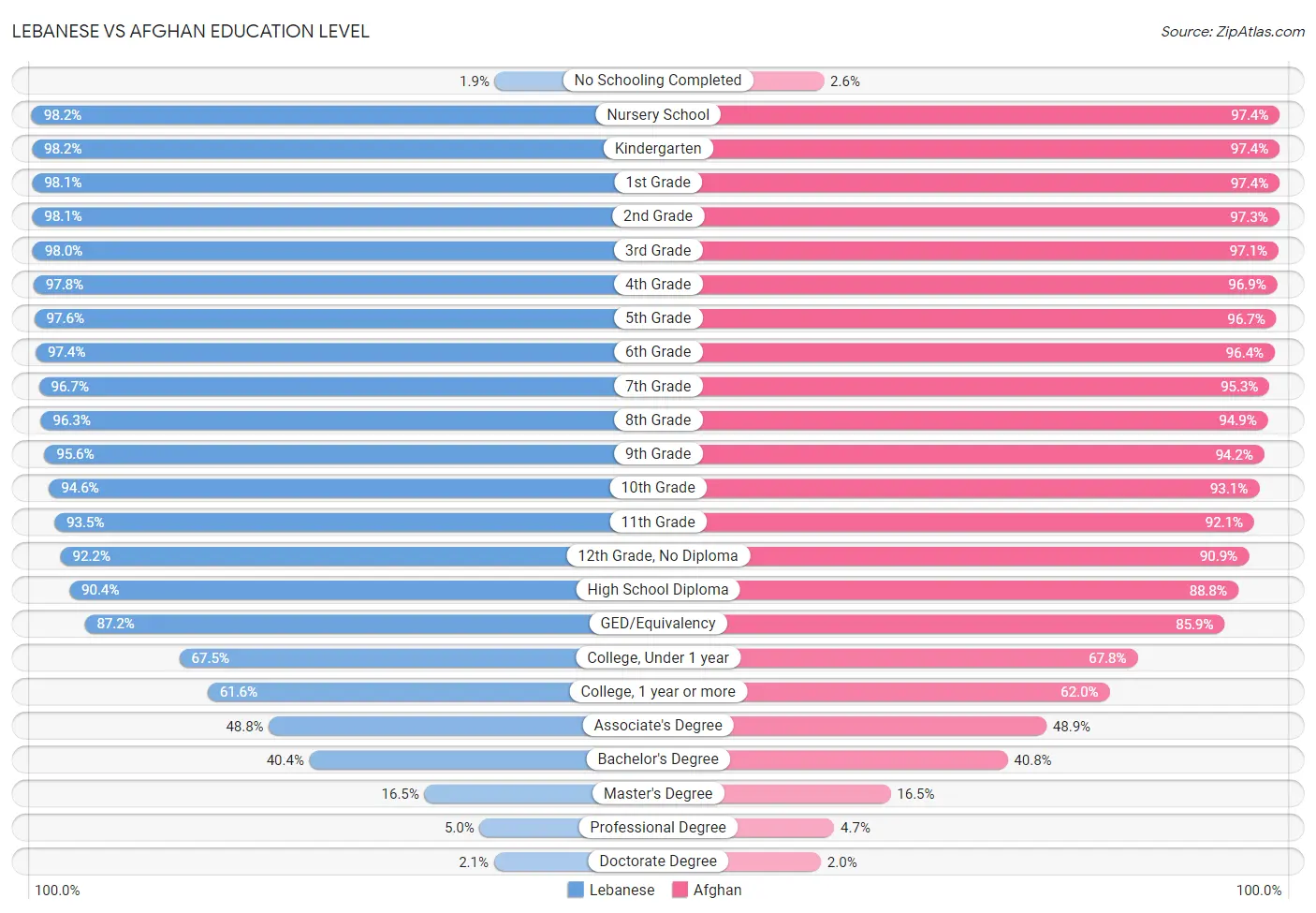
| Education Level Metric | Lebanese | Afghan |
| No Schooling Completed | Exceptional 1.9% | Tragic 2.6% |
| Nursery School | Exceptional 98.2% | Tragic 97.4% |
| Kindergarten | Exceptional 98.2% | Tragic 97.4% |
| 1st Grade | Exceptional 98.1% | Tragic 97.4% |
| 2nd Grade | Exceptional 98.1% | Tragic 97.3% |
| 3rd Grade | Exceptional 98.0% | Tragic 97.1% |
| 4th Grade | Exceptional 97.8% | Tragic 96.9% |
| 5th Grade | Exceptional 97.6% | Tragic 96.7% |
| 6th Grade | Exceptional 97.4% | Tragic 96.4% |
| 7th Grade | Exceptional 96.7% | Tragic 95.3% |
| 8th Grade | Exceptional 96.3% | Tragic 94.9% |
| 9th Grade | Exceptional 95.6% | Tragic 94.2% |
| 10th Grade | Exceptional 94.6% | Tragic 93.1% |
| 11th Grade | Exceptional 93.5% | Poor 92.1% |
| 12th Grade, No Diploma | Exceptional 92.2% | Fair 90.9% |
| High School Diploma | Exceptional 90.4% | Fair 88.8% |
| GED/Equivalency | Exceptional 87.2% | Average 85.9% |
| College, Under 1 year | Exceptional 67.5% | Exceptional 67.8% |
| College, 1 year or more | Exceptional 61.6% | Exceptional 62.0% |
| Associate's Degree | Exceptional 48.8% | Exceptional 48.9% |
| Bachelor's Degree | Exceptional 40.4% | Exceptional 40.8% |
| Master's Degree | Exceptional 16.5% | Exceptional 16.5% |
| Professional Degree | Exceptional 5.0% | Excellent 4.7% |
| Doctorate Degree | Exceptional 2.1% | Excellent 2.0% |
Lebanese vs Afghan Disability
When considering disability, the most significant differences between Lebanese and Afghan communities in the United States are seen in disability age under 5 (1.3% compared to 0.94%, a difference of 39.9%), hearing disability (3.2% compared to 2.7%, a difference of 17.1%), and male disability (11.5% compared to 10.2%, a difference of 12.0%). Conversely, both communities are more comparable in terms of disability age 65 to 74 (22.5% compared to 22.6%, a difference of 0.63%), self-care disability (2.4% compared to 2.4%, a difference of 1.0%), and cognitive disability (17.0% compared to 17.3%, a difference of 2.1%).
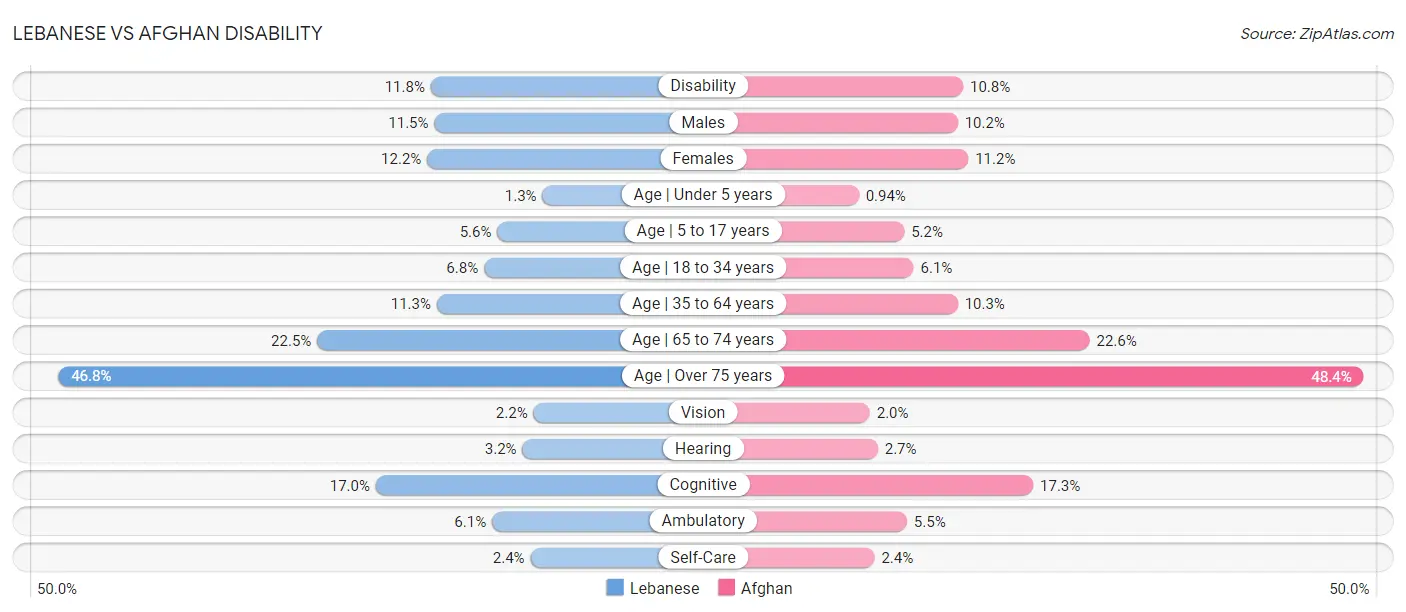
| Disability Metric | Lebanese | Afghan |
| Disability | Fair 11.8% | Exceptional 10.8% |
| Males | Poor 11.5% | Exceptional 10.2% |
| Females | Average 12.2% | Exceptional 11.2% |
| Age | Under 5 years | Tragic 1.3% | Exceptional 0.94% |
| Age | 5 to 17 years | Good 5.6% | Exceptional 5.2% |
| Age | 18 to 34 years | Poor 6.8% | Exceptional 6.1% |
| Age | 35 to 64 years | Average 11.3% | Exceptional 10.3% |
| Age | 65 to 74 years | Exceptional 22.5% | Excellent 22.6% |
| Age | Over 75 years | Excellent 46.8% | Tragic 48.4% |
| Vision | Average 2.2% | Exceptional 2.0% |
| Hearing | Tragic 3.2% | Exceptional 2.7% |
| Cognitive | Exceptional 17.0% | Fair 17.3% |
| Ambulatory | Good 6.1% | Exceptional 5.5% |
| Self-Care | Good 2.4% | Excellent 2.4% |